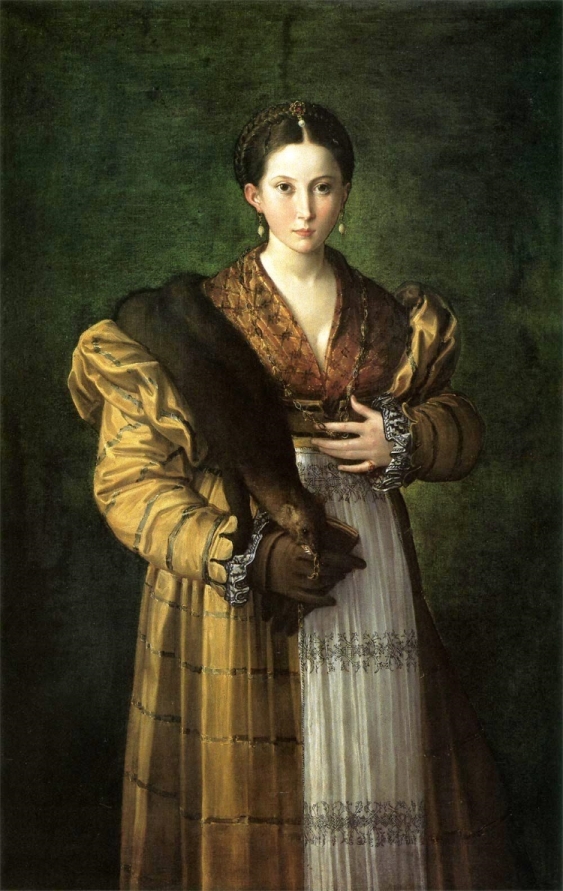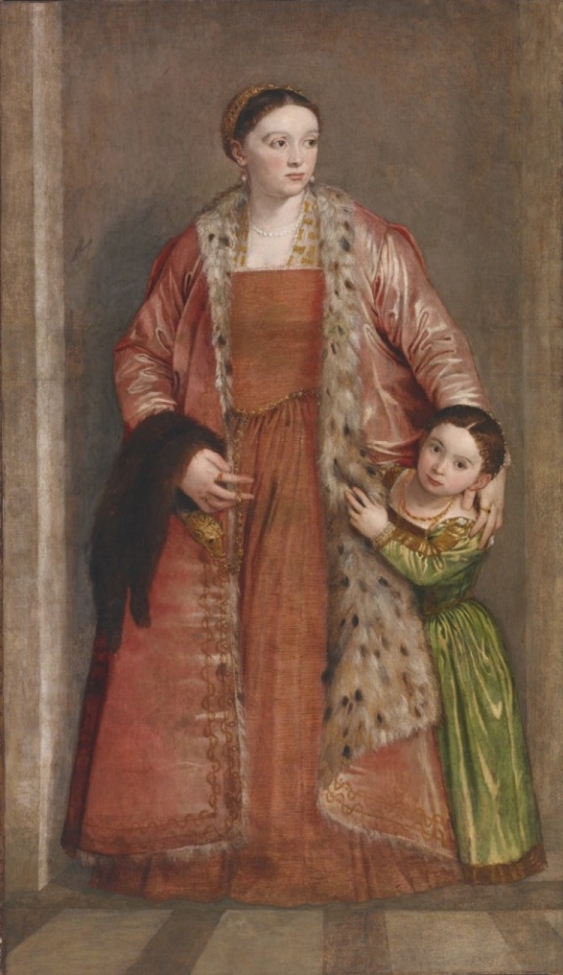
Do you want to give someone a memorable wedding gift? Why not take your inspiration from Renaissance art and give them a painting of a sexy weasel?
In the 16th century, weasels were a catch-all category for many of the furry, long-bodied carnivorous creatures in the mustelid family, such as ermine, sables, martens, ferrets, stoats and mink. These creatures often appear in Renaissance portraits of high-ranking noblewomen, and represent a fascinating language of sexual symbolism. Explore some of the hidden meanings of weasels below!
1. Weasels as fertility talismans

In the Renaissance, weasel paintings were ideal wedding gifts because they were considered to be fertility talismans. A portrait of a young bride wearing an ermine, sable or mink, for instance, was believed to bring good luck in helping her to get pregnant.
The marriage painting above by Lavinia Fontana shows a young Bolognese noblewoman wearing a red wedding gown. On the left, she pats a little white dog — a symbol of marital fidelity. On the right, she holds a weasel pelt with a sumptuously jeweled head — a popular accessory in the 15th and 16th centuries known as a zibellino or flea-fur. Here, the inclusion of the flea-fur represents the hope that this bride would be blessed with good fertility.

In the Renaissance, it was widely believed that weasels conceived through their ears and gave birth through their mouth. This ‘miraculous’ method of conception was thought to parallel the Annunciation of Christ, who was conceived when God’s angel whispered into the ear of the Virgin Mary.
In the portraits below, you can see how the brides are touching their wombs while holding a weasel pelt — hope that the Lord will too bless them with the ‘miracle’ of pregnancy. (Hopefully her husband knows better than to try and put it in her ear though…)




2. Weasels and childbirth

Weasels sometimes also appear in Renaissance paintings where the woman is already successfully pregnant. In these cases, the weasel can better be understood to represent the hope for safe childbirth.
Some believed that wearing weasel fur directly on the skin could also help ease childbirth. Letters between Christina de Medici, the Grand Duchess of Tuscany, and her daughter Catherine, for instance, show that the Dowager sent her daughter an ermine or marten belt when Catherine was believed to be pregnant, claiming that it had helped her during the birth of her children.
In the portrait above by Paolo Veronese, Countess da Porto is pictured with her daughter Diedama, and is already pregnant with her second daughter Emilia. Over her arm is draped the pelt of a marten, which was thought to be particularly powerful for protecting women during childbirth.

Interestingly, there is a flea-fur in the Walters Art Museum almost identical to the one portrayed in this portrait. The white dove on its snout is a symbol of the Holy Ghost, further emphasizing the symbolic connection between the weasel and Christ’s miraculous birth.

3. Weasels and phallic symbols
With their long, powerful bodies and connection with fertility, weasels are also sometimes associated with other phallic imagery in Renaissance paintings.
One of my favorite examples is this portrait of Camilla Gonzaga, surrounded by her three sons while grasping a fine weasel pelt draped over her shoulder.

At first, there doesn’t seem to be anything particularly phallic about this weasel. Until you consider it alongside the companion painting of her husband, Count Pier Maria di San Secondo, who commissioned the portraits:

These two portraits were designed to hang side by side, as a tribute to Count San Secondo’s virility. In his portrait, the prominent codpiece and a strategically-placed sword handle are intended to be seen as tributes to his masculinity and the strength of his family line.
Camilla gazes proudly at her husband, surrounded by the sons he has successfully sired, while stroking her jeweled weasel pelt. The son on the left stares straight at his father’s codpiece with a strange expression on his face — perhaps pondering the ideals of masculinity he would be expected to live up to?
Hardly subtle.


4. Weasels and purity

Leonardo da Vinci’s Lady with an Ermine (circa 1490) is the most famous Renaissance weasel painting. Like many others of his day, Leonardo believed that white ermine would rather give themselves up to hunters rather than risk soiling their pristine fur in the chase. The white weasel here can therefore be understood as a symbol of the girl’s purity.
However, the portrait depicts the pregnant 16-year old mistress of Leonardo’s employer, the Duke of Milan. The duke belonged to a society of knights known as the Order of the Ermine, so this weasel also stands in for him. Notice how sensuously she strokes the weasel, and how weirdly muscular it is. The ermine is both meant as a symbol of the girl’s purity and the duke’s virility. Cheeky Leonardo…
The white ermine is also used in this portrait of Queen Elizabeth I (circa 1585) below. Elizabeth I never married, and was sometimes called the Virgin Queen. Here, the white weasel is included to assert the political power associated with her purity and unmarried status.


5. Weasels as status symbols
Mink, sable and marten fur was historically very valuable. So including a weasel pelt in a woman’s portrait was also simply a way of indicating their high social-standing and successful financial position.
These pelts were sometimes known as flea-furs, because they were believed to draw fleas away from biting the noblewoman’s skin. Unsurprisingly, scratching at itchy fleabites has never been a fashionable look for ladies.




However, in addition to social or financial success, weasels could also indicate reproductive success — an important measure of a woman’s value during a period with high infant and child mortality rates.
This is demonstrated in the portrait of the Gozzadini Family (1584) by Lavinia Fontana, below. The painting was commissioned by Laudomia Gozzadini, who sits on the right. Her sister Ginevra, on the left, gave birth six times before her death at age 28, with three sons who survived infancy. The flea-fur on her lap pays tribute to Ginevra’s reproductive success.
Laudomia, on the other hand, remained childless, dedicating her life to the financial interests of drama-filled Gozzadini family. She is pictured with the fur of a lynx, a symbol of barrenness, and a dog, a symbol of fidelity to her extended family.


So which sexy weasel would you choose for your wedding gift: fertility weasel, childbirth weasel, phallic weasel, purity weasel, or success weasel? This sounds like the beginnings of a very terrible, very niche Buzzfeed quiz.
Also, I refuse to put up one of those obnoxious “SIGN UP NOW!” pop-ups on the site, because I find them ridiculously annoying. But I would still really love it if you subscribed to The Museum of Ridiculously Interesting Things below, or followed me on Instagram or Facebook! If you’ve gone this far into an article about art and sex weasels, I’m almost certain there will be more weird stuff there you’ll be into.
